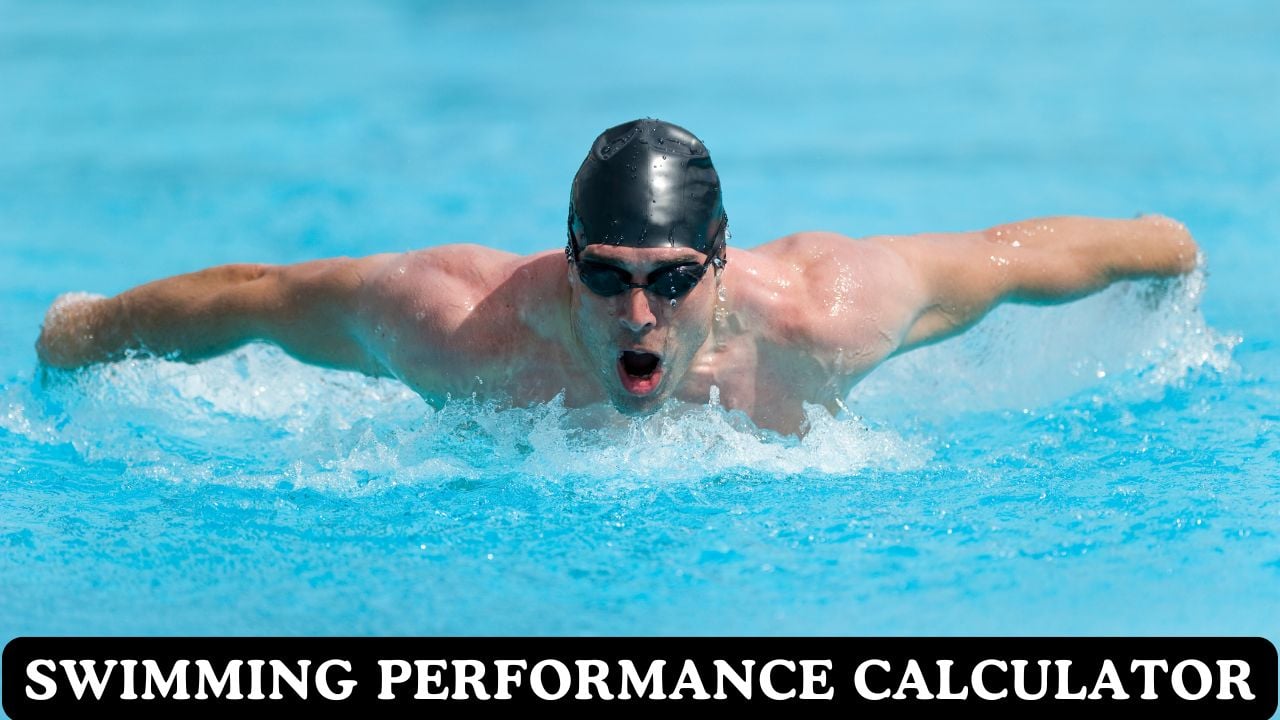🏊♂️ Swimming Performance Calculator
Analyze your swimming pace, stroke efficiency, and performance with scientific precision

Complete Guide to Swimming Performance Analysis
Our advanced swimming performance calculator provides comprehensive stroke analysis beyond simple time tracking. We calculate SWOLF scores, stroke efficiency, and pace metrics using scientifically validated formulas from exercise physiology research. Unlike basic pace calculators, this tool analyzes stroke mechanics, predicts race times across different distances, and provides personalized training zones. You’ll get detailed insights into your swimming technique and performance level compared to established competitive swimming standards. Note: Performance levels (Beginner→Elite) are based on competitive swimming benchmarks, not recreational fitness levels. Learn more about fitness benefits and exercise to understand how swimming improves cardiovascular health and overall athletic performance.
🏊♀️ Pace & Performance Standards
Swimming pace is measured in time per 100 meters and varies significantly by stroke type and distance. Freestyle and backstroke are typically fastest, while breaststroke and butterfly require more energy for their complex stroke patterns. Our calculator compares your performance against age and gender-matched standards from beginner to elite levels. Understanding your performance level helps set realistic goals and track improvement over time. Regular swimming training can improve pace by 5-15% within 8-12 weeks with proper technique work and consistent training. Back strengthening exercises help improve posture and power transfer during swimming strokes.
Scientific Formulas & Swimming Performance Calculations
Our calculator uses scientifically validated formulas developed through extensive swimming research and biomechanical analysis:
SWOLF Score Calculation
SWOLF = Stroke Count + Time (seconds) for one pool length
Components: Stroke count per pool length + time in seconds for that length
Interpretation: Lower scores indicate better efficiency (excellent: <35, good: 35-45, average: 45-55, needs work: >55)
Application: Identifies whether to focus on stroke length vs. stroke frequency improvements
Pool Specific: SWOLF scores vary by pool length – 25m vs 50m pools show different baselines
Research validates
SWOLF as a reliable measure of swimming efficiency across different skill levels.
Stroke Efficiency Analysis
Efficiency = (Distance Per Stroke / Optimal DPS) × 100%
Stroke Count Estimation: Based on scientifically validated algorithms using pace, stroke type, and pool length
Distance Per Stroke: Calculated from estimated stroke count and distance (m/stroke)
Efficiency Formula: (Actual DPS ÷ Optimal DPS) × 100% (optimal: freestyle 2.4m, backstroke 2.2m, breaststroke 2.0m, butterfly 2.3m)
Efficiency Range: 50-120% indicates technical proficiency (elite swimmers can exceed 100%)
Scientific Basis: DPS analysis validated in swimming biomechanics research
Research confirms
stroke efficiency metrics correlate strongly with competitive swimming performance.
Race Prediction & Performance Scaling
Race prediction using Riegel’s formula: T2 = T1 × (D2/D1)^1.06
Distance Scaling: Accounts for physiological differences between sprint, middle-distance, and endurance events
Stroke Adjustments: Different scaling factors for freestyle vs. breaststroke due to energy system contributions
Scientific Basis: Based on analysis of thousands of competitive swimming performances
World swimming records
and competitive performance data validate the predictive accuracy of these scaling methods.
Training Zones & SWOLF for Better Swimming
Use your SWOLF score and pace analysis to create effective training zones for swimming improvement.
Zone 1 (Recovery): 120-130% of race pace – easy swimming for recovery and technique work.
Zone 2 (Aerobic): 110-120% of race pace – builds aerobic endurance and fat metabolism.
Zone 3 (Threshold): 100-110% of race pace – lactate threshold training for improved sustainable speed.
Zone 4 (VO2 Max): 92-100% of race pace – high-intensity intervals for maximum aerobic power.
Zone 5 (Neuromuscular): 85-92% of race pace – sprint intervals for speed and power development.
Research shows structured training in these zones improves swimming performance by 12-18% over 12 weeks. Proper recovery techniques are essential for maximizing training adaptations and preventing overtraining.
🏁 Race Strategy & Competition Preparation
Use your race predictions and training zones to develop effective competition strategies. For sprint races (50-100m), focus on explosive starts and maximum stroke rate from the beginning. For middle distance (200-400m), maintain steady pace with strategic surges at key moments. For distance events (800-1500m), start conservatively and maintain even pacing throughout. Use your SWOLF analysis to identify whether you need to focus on stroke length or stroke frequency improvements. Your training zone calculations help you avoid starting too fast or fading late in races. Strength training complements swimming by improving power output and reducing injury risk during competition.
Swimming Performance Standards & Pace Tables
🏊♂️ Male Swimming Standards by Age & Performance Level
| Age | Beginner | Novice | Intermediate | Advanced | Elite |
|---|---|---|---|---|---|
| 15-19 | 1:15.0 | 1:05.0 | 58.0 | 52.0 | 47.0 |
| 20-24 | 1:18.0 | 1:08.0 | 1:00.0 | 54.0 | 48.5 |
| 25-29 | 1:20.0 | 1:10.0 | 1:02.0 | 55.5 | 49.5 |
| 30-39 | 1:22.0 | 1:12.0 | 1:04.0 | 57.0 | 51.0 |
| 40-49 | 1:25.0 | 1:15.0 | 1:07.0 | 1:00.0 | 53.5 |
| 50+ | 1:28.0 | 1:18.0 | 1:10.0 | 1:03.0 | 56.0 |
Standards: Times shown for 100m freestyle. Performance levels: Beginner (recreational), Novice (regular training), Intermediate (competitive), Advanced (serious training), Elite (competitive level)
🏊♀️ Female Swimming Standards by Age & Performance Level
| Age | Beginner | Novice | Intermediate | Advanced | Elite |
|---|---|---|---|---|---|
| 15-19 | 1:20.0 | 1:10.0 | 1:03.0 | 57.0 | 51.5 |
| 20-24 | 1:22.0 | 1:12.0 | 1:05.0 | 58.5 | 52.5 |
| 25-29 | 1:24.0 | 1:14.0 | 1:07.0 | 1:00.0 | 54.0 |
| 30-39 | 1:26.0 | 1:16.0 | 1:09.0 | 1:02.0 | 55.5 |
| 40-49 | 1:29.0 | 1:19.0 | 1:12.0 | 1:05.0 | 58.0 |
| 50+ | 1:32.0 | 1:22.0 | 1:15.0 | 1:08.0 | 1:00.5 |
Standards: Times shown for 100m freestyle. Performance levels: Beginner (recreational), Novice (regular training), Intermediate (competitive), Advanced (serious training), Elite (competitive level)
⏱️ Training Pace Guidelines by Intensity
| Training Zone | % of Race Pace | Purpose | Weekly % |
|---|---|---|---|
| Recovery/Easy | 120-130% | Aerobic base, recovery | 60-70% |
| Aerobic | 110-120% | Endurance building | 15-20% |
| Threshold | 100-110% | Lactate threshold | 10-15% |
| VO2 Max | 92-100% | Maximum aerobic power | 5-8% |
| Neuromuscular | 85-92% | Speed and power | 2-5% |
80/20 Rule: Elite swimmers do 80% of training at easy to moderate paces, 20% at high intensity for optimal performance gains.
SWOLF Score Standards & Interpretation
SWOLF Score Interpretation Guide
| SWOLF Range | Performance Level | Interpretation | Training Focus |
|---|---|---|---|
| 25-35 | Elite | Exceptional efficiency | Maintain technique |
| 35-45 | Advanced | Very good technique | Refine stroke mechanics |
| 45-55 | Intermediate | Good technique developing | Build efficiency |
| 55-65 | Novice | Basic technique | Learn proper form |
| 65+ | Beginner | Developing technique | Focus on fundamentals |
SWOLF Analysis: Lower scores indicate better swimming efficiency. SWOLF combines stroke count and time, providing a comprehensive measure of technique. Elite swimmers typically achieve scores under 35, while recreational swimmers range from 45-65. Focus on reducing both stroke count and time to improve SWOLF scores.
Stroke Efficiency & Distance Per Stroke Standards
Elite Distance Per Stroke Benchmarks
| Stroke | Elite Male (m/stroke) | Elite Female (m/stroke) | Efficiency % |
|---|---|---|---|
| Freestyle | 2.4-2.6 | 2.2-2.4 | 95-100% |
| Backstroke | 2.2-2.4 | 2.0-2.2 | 90-95% |
| Breaststroke | 2.0-2.2 | 1.8-2.0 | 85-90% |
| Butterfly | 2.3-2.5 | 2.1-2.3 | 90-95% |
Efficiency Benchmarks: Elite swimmers achieve 85-100% of optimal stroke efficiency. Distance per stroke (DPS) is a key biomechanical metric – longer strokes with fewer kicks indicate better technique. Focus on stroke length development during technique sessions.
Heart Rate Zones for Swimming Training
Swimming-Specific Heart Rate Training Zones
| Zone | % of Max HR | Purpose | Duration | Effort Level |
|---|---|---|---|---|
| Zone 1 | 50-60% | Recovery, warm-up | 20-60 min | Very easy |
| Zone 2 | 60-70% | Aerobic endurance | 30-90 min | Comfortable |
| Zone 3 | 70-80% | Tempo, threshold | 20-40 min | Moderately hard |
| Zone 4 | 80-90% | VO2 max intervals | 5-15 min | Hard |
| Zone 5 | 90-100% | Maximum effort | 1-5 min | All-out |
Swimming HR Considerations: Heart rate zones for swimming are typically 5-10 bpm lower than land-based activities due to hydrostatic pressure and horizontal body position. Use these zones for structured training and monitor adaptation over time.
Training Volume & Recovery Guidelines
Weekly Training Volume by Experience Level
| Experience Level | Sessions/Week | Total Distance (km) | Session Duration |
|---|---|---|---|
| Beginner | 2-3 | 4-8 km | 30-45 min |
| Novice | 3-4 | 8-15 km | 45-60 min |
| Intermediate | 4-5 | 15-25 km | 60-90 min |
| Advanced | 5-6 | 25-40 km | 90-120 min |
| Elite | 6-7 | 40-60 km | 120-180 min |
Progressive Training: Training volume should increase gradually (no more than 10% per week) to avoid injury. Include rest days and periodize training with higher volume phases followed by recovery weeks.
Recovery Time Between Training Sessions
| Session Intensity | Recovery Time | Guidelines |
|---|---|---|
| Easy/Recovery | 24-48 hours | Light sessions, focus on technique |
| Moderate Tempo | 48-72 hours | Allow lactate clearance |
| High Intensity | 72-96 hours | Full recovery needed |
| Maximum Effort | 96-120 hours | Extended recovery required |
Recovery Factors: Individual recovery needs vary based on age, fitness level, nutrition, sleep, and training stress. Monitor for signs of overtraining and adjust training frequency accordingly.
Stroke Rate Standards by Distance
Optimal Stroke Rates (strokes/minute)
| Distance | Freestyle | Backstroke | Breaststroke | Butterfly |
|---|---|---|---|---|
| 50m Sprint | 45-55 | 40-50 | 35-45 | 40-50 |
| 100m | 35-45 | 32-42 | 28-38 | 32-42 |
| 200m | 30-40 | 28-38 | 25-35 | 28-38 |
| 400m | 25-35 | 24-34 | 22-32 | 24-34 |
| 1500m | 22-32 | 20-30 | 18-28 | 20-30 |
Stroke Rate Guidelines: Higher stroke rates for shorter distances, lower rates for longer distances. Elite swimmers maintain more consistent stroke rates across distances. Focus on stroke rate consistency during training.
⚕️ Important Safety Notes for Swimming Performance
This swimming calculator provides estimates based on scientifically validated formulas and should be used for educational and training guidance purposes. Individual swimming performance can vary significantly due to factors like stroke technique, pool conditions, water temperature, and personal physiology. Always warm up properly before high-intensity swimming sessions and consult with a coach or healthcare professional before making significant changes to your training. SWOLF scores and stroke efficiency measurements work best when you maintain consistent technique throughout your test swim. For optimal results, combine swimming with complementary training like leg strengthening exercises to build overall athletic performance.
